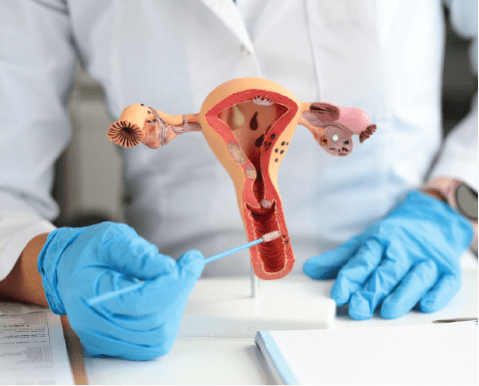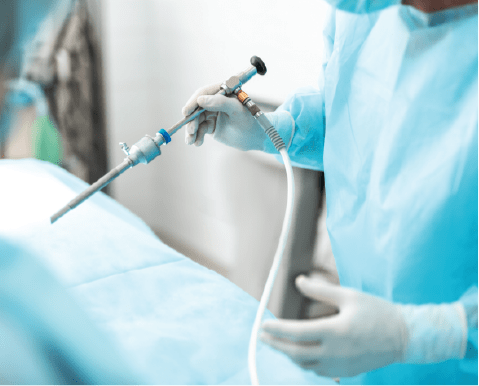A colposcopy is a relatively minor and simple procedure, similar to a cervical screening test or a pap smear, that usually only takes 5-10 minutes. Dr Siva performs colposcopy in his rooms at St. Andrew’s Ipswich Private Hospital.
Why do I need to have a colposcopy?
If your cervical screening test delivers an abnormal result, such as human papillomavirus (HPV) or cervical cell changes, your GP may refer you to Dr Siva for a colposcopy appointment.
Your GP might also refer you to Dr Siva for a colposcopy if you have unusual or unexplained bleeding or an abnormal lump or growth on your cervix or vagina.
A colposcopy is the primary tests for diagnosing and presenting cervical cancer, vulvar and vaginal cancers and it is used to investigate, diagnose and prevent conditions such as:
- benign growths
- cervical cancer
- cervical polyps
- genital warts
- inflammation of the cervix
- precancerous cells – these are abnormal cells that can become cancerous if left untreated.
Dr Siva is accredited to perform colposcopy to manage abnormal cervical screening test results such as low grade squamous epithelial lessons (LSIL) and high grade squamous epithelial lesions (HSIL).
What is the difference between a cervical screening test, a pap smear and a colposcopy?
The cervical screening test looks and feels like a pap smear, however it has now replaced the pap smear. While the pap smear was used to search for changes in the cells of the cervix (the entrance to the uterus from the vagina), the cervical screening test instead looks for evidence of the human papillomavirus (HPV), which can lead to these cell changes in the cervix.
If your cervical screening test results are normal, you’ll only need to have a cervical screening test done every 5 years, however if it shows changes to the cells in your cervix, you’ll need to have the test done every year and you’ll be referred to your gynaecologist for a colposcopy to further evaluate these changes.
A colposcopy looks and feels the same as a cervical screening test, however it is only performed if you have an abnormal cervical screening test result and it is performed by your gynaecologist using a colposcope.
What is a colposcopy?
A colposcopy is a speculum examination performed on a special gynaecological chair in your gynaecologist’s rooms. You will lie on your back, with your legs might be raised and supported in stirrups while your gynaecologist inserts a speculum to open your vagina.
During a colposcopy, your gynaecologist will use a colposcope, which is a special magnifying instrument that looks like a pair of binoculars with a bright light, allowing your gynaecologist a greatly magnified view of the surface of your vagina and cervix. The colposcope does not enter your body.
Fluid is applied to your cervix to highlight any cell changes that can only be seen when looked at with the colposcope. If there are changes to your cervix and the area requires further investigation, a tiny piece of tissue a few mm in length is taken and sent to a laboratory for a biopsy.
Results of your biopsy will usually be back within a week and observation or treatment of any cell changes will then be planned. Treatment, if required, will usually involve a large loop excision of the transformation zone (LLETZ) procedure to remove any abnormal cells.
Large Loop Excision of the Transformation Zone (LLETZ) procedure
LLETZ stands for large loop excision of the transformation zone, a common and highly effective treatment to remove cell changes (abnormal cells) in your cervix. During a LLETZ procedure an electrical wire (diathermy) is used to shave abnormal cells off your cervix, leaving only the healthy tissue.
The LLETZ procedure is successful in over 90% of cases to stop any cell changes developing into cervical cancer, meaning no further treatment is needed.
What happens during a LLETZ procedure?
LLETZ is a simple and safe surgical procedure that only takes about 15-30 minutes. Dr Siva performs LLETZ in an operating theatre under general or local anaesthetic as a day case, meaning there is usually no overnight hospital stay required.
During the LLETZ procedure you lie on your back on an examination couch as a clean speculum is inserted into your vagina, similar to a cervical screening test. If you are not having a general anaesthetic, a local anaesthetic will be injected into your cervix to make it numb.
As the LLETZ loop shaves off the area of your cervix that has cell changes you might notice a slight burning smell and hear a noise like a soft vacuum cleaner. After the loop has removed the tissue, another small instrument is used to seal the cut.
Any cells and tissue that have been removed are now sent to a lab to be biopsied, checking what kind of cell changes you have and whether all cell changes have been completely removed.
After your LLETZ treatment, you will be contacted with your biopsy results after 7-10 days. For most patients, following the LLETZ procedure, you would need a CST with your GP in 12 months time.
To find out more about colposcopy or the LLETZ procedure, get in touch with Dr Siva’s rooms.
Colposcopy FAQs
A colposcopy can take anywhere between about 5 – 15 minutes, depending on whether a tissue sample has to be taken or not. Allow approximately 30 minutes in total for your colposcopy appointment.
Although a colposcopy can feel awkward and uncomfortable, it is relatively painless. You might feel slight pressure when the speculum enters your vagina, a slight burning or stinging when the solution comes into contact with your cervix or a slight pinching or cramping sensation if a tissue sample has to be taken.
A colposcopy procedure is usually done when you are not menstruating, however you should discuss this with Dr Siva.
For 24 to 48 hours beforehand, you should not:.
- douche
- have sexual intercourse
- use vaginal medicines
- wear tampons
If you didn’t need a tissue sample and a biopsy, you should be able to resume normal activities right away.
After a biopsy, you might experience cramps, some spotting, vaginal discharge or bleeding for up to 5 or 6 days. Avoid heavy exercise, swimming, bathing (showering is fine) for 2 days. It is normal to have a little spotting for 2-5 days after a colposcopy, especially if you have also had a biopsy.
Avoid penetrative sex or using tampons for at least a week after a biopsy to minimise the risk of infection.
You will not need a general anaesthetic or a hospital stay for a colposcopy, however a local anaesthetic may be required if Dr Siva needs to biopsy a particularly sensitive area.
Dr Siva performs all of his colposcopies in his rooms, located at St. Andrew’s Ipswich Private Hospital.
Yes it does. It takes approximately four- to six weeks for new healthy tissue to grow on your cervix to replace the removed abnormal tissue.
Dr Siva’s rooms will contact you with the results of your biopsy and arrange a follow up appointment for further treatment, if required.
While some spotting is to be expected, please contact Dr Siva if:
- you experience heavy bleeding
- your bleeding that lasts longer than 5-7 days
- you develop a temperature
- your vaginal discharge is smelly
- you experience severe and ongoing abdominal pain and cramping
LLETZ FAQs
Your cervix should heal itself anywhere from three to six weeks. Any vaginal discharge and bleeding will stop as soon as your cervix is healed.
Some cramping pain, like a period, is to be expected for up to 4 weeks after treatment. Although the pain varies from person to person, it should not be too severe and over-the-counter pain relief medication usually helps.
After the anaesthetic has worn off, you may experience pain, vaginal bleeding and changes to vaginal discharge for up to 4 weeks. Bleeding can vary from slight to as much as a light period.
For one to two weeks you should avoid heavy exercise and for the first 3-4 weeks you should avoid intercourse, swimming, bathing, douching and using tampons.
ANY FURTHER QUESTIONS?
Please feel free to get in touch with Dr Siva’s rooms via email ipswichgyn@gmail.com or call (07) 3816 9189
for any further questions about our appointments, fees or anything else.





